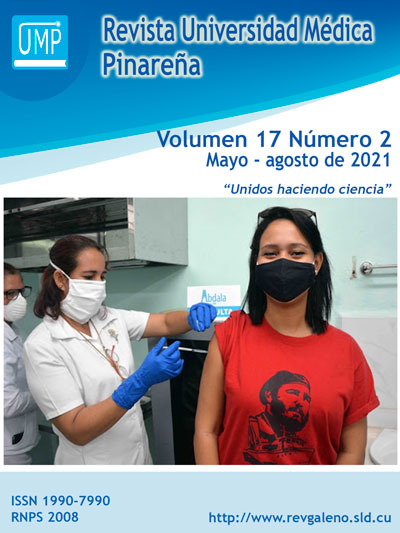Preliminary report on the use of optic nerve sheath ultrasound for the diagnosis of intracranial hypertension in patients with cerebrovascular disease
Keywords:
Ultrasonography, Optic Nerve, Intracranial Hypertension, Stroke, Diagnostic ImagingAbstract
Introduction: intracranial hypertension is a serious, life-threatening condition that can occur in patients with cerebrovascular disease. Its diagnosis is made by catheterization of the ventricular system or by non-invasive techniques such as ultrasound of the optic nerve sheath.
Objective: to assess the usefulness of ultrasound of the optic nerve sheath for the diagnosis of intracranial hypertension in patients treated with cerebrovascular disease.
Method: observational, descriptive and cross-sectional research in 35 patients admitted for cerebrovascular disease in the Internal Medicine and Intensive Medicine services of the “Mártires del 9 de Abril” University Hospital. Ultrasound of the optic nerve sheath, fundus and computerized axial tomography of the skull were performed to diagnose signs of intracranial hypertension. Ultrasound of the optic nerve sheath showed a specificity of 80% and a positive predictive value of 87% for the detection of intracranial hypertension.
Results: A predominance of males was reported (71,43 %), and of patients with white skin color (82,86 %). The mean age was 74,5 years, while the mean stay of the patients was 9,7 days. Hypertension was shown as the main personal pathological history (79,99 %) and was associated with the occurrence of cerebrovascular disease (p <0,01). Mortality from this entity was 60 %
Conclusions: the measurement of the diameter of the optic nerve sheath by ultrasound in patients with a diagnosis of cerebrovascular disease is useful to evaluate the presence of intracranial hypertension.
Downloads
References
2. Kozaci L, Avci M, Caliskan G. Variability of optic nerve sheath diameter in acute ischemic stroke. Hong Kong J Emerg Med [Internet]. 2020 [citado 15/01/2021];27:223-28. Disponible en: https://journals.sagepub.com/doi/full/10.1177/1024907919842982
3. Long B, Koyfman A, Gotlieb M. Accuracy of Physical Examination and Imaging Findings for the Diagnosis of Elevated Intracranial Pressure. Acad Emerg Med [Internet]. 2020 [citado 15/02/2021]; 27:921-22. Disponible en: https://onlinelibrary.wiley.com/doi/full/10.1111/acem.13928
4. Wang LJ, Chen HX, Chen Y, Yu ZY, Xing Y. Optic nerve sheath diameter ultrasonography for elevated intracranial pressure detection. Ann Clin Transl Neurol[Internet]. 2020 [citado 15/02/2021]; 7:865-68. Disponible en: https://onlinelibrary.wiley.com/doi/full/10.1002/acn3.51054
5. Hansen C, Helmeke K, Kunze K. Optic nerve sheath Enlargement in Acute Intracranial Hypertension. Neuro-Ophthalmology. [Internet]. 2016 [citado 30/01/2021]; 14:345-354. Disponible en: http://dx.doi.org/10.1097/WCO.0000000000000098
6. Hightower S, Chin E, Heiner J. Detection of Increased Intracranial Pressure by Ultrasound. Journal of Special Operations Medicine [Internet]. 2015, [citado 30/01/2021]; 12:19-22. Disponible en: http://dx.doi.org/10.3341/kjo.2012.26.2.116
7. Ohle R, McIsaac SM,Woo MY, Perry JJ. Sonography of the Optic Nerve SheathDiameter for Detection of RaisedIntracranial Pressure Compared toComputed Tomography. J Ultrasound Med [Internet]. 2015[citado 30/01/2021]; 34:1285–1294. Disponible en: https://onlinelibrary.wiley.com/doi/pdf/10.7863/ultra.34.7.1285
8. Kim SE, Hong EP, Kim HC, Lee SI, Jeon JP. Ultrasonographic optic nerve sheath diameter to detect increased intracranial pressure in adults: a meta-analysis. Acta Radiol [Internet]. 2019[citado 30/01/2021];60:221-29. Disponible en: https://journals.sagepub.com/doi/10.1177/0284185118776501
9. Sociedad Española de Médicos de Atención Primaria. Calculadora on line (evaluación de una prueba diagnóstica). [Internet]. [citado 30/01/2021] Disponible en: http://www.semergencantabria.org/calc/amcalc.htm
10. Perdomo B, Rodríguez T, Fonseca M, Urquiza I, Martínez IL, Bilaboy BR. Caracterización de pacientes con enfermedad cerebrovascular isquémica y deterioro cognitivo. Cienfuegos, 2018. Medisur [Internet]. 2020 [citado 8/02/2021];18:333-344. Disponible en: http://scielo.sld.cu/scielo.php?script=sci_arttext&pid=S1727-897X2020000300333&lng=es
11. Puy L. Jouvent E. Accidente cerebrovascular en el paciente anciano.EMC Tratado de Medicina [Internet]. 2020 [citado 8/02/2021];24:1-6. Disponible en: https://www.sciencedirect.com/science/article/pii/S163654102043329X
12. Piloto A, Suárez B, Belaunde A, Castro M. La enfermedad cerebrovascular y sus factores de riesgo. Rev Cub Med Mil [Internet].2020 [citado 15/02/2021];49:e0200568. Disponible en: http://www.revmedmilitar.sld.cu/index.php/mil/article/view/568/550
13. Gökcen E, Caltekin I, Savrun A, Korkmaz I, Tuba Ş, Yildirim G. Alterations in optic nerve sheath diameter according to cerebrovascular disease sub-groups. Am J Emerg Med [Internet]. 2017 citado 15/02/2021];35:1607-11. Disponible en: https://www.sciencedirect.com/science/article/abs/pii/S0735675717303601







